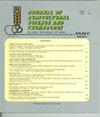The Seasonal Occurrence and Selecting a Pesticide Against Major Insect Pests Occurring in Greenhouse-grown Hydrangea in Jeonnam Province
IF 1.3
4区 农林科学
Q2 AGRICULTURE, MULTIDISCIPLINARY
引用次数: 1
Abstract
This study has been made for the seasonal occurrence of major insect pests which occurred in greenhouse-grown hydrangea and the selection of pesticide from March 2013 to December 2014. Major insect pests included Tea red spider mite (Tetranychus kanzawai Kishida), Garden thrips (Frankliniella intonsa), and Melon aphid (Aphis gossypii glover). And among them, insect pests requiring being controlled were T. kanzawai, and F. intonsa. With regard to seasonal occurrence, T. kanzawai occurred in mid-March, and showed the peak period of occurrence in early June, and then showed that it tended to rapidly decrease. F. intonsa started to occur from early April, and its peak period of occurrence was late-June. With regard to the selection of pesticide, in case of T. kanzawai, 4 types such as abamectin emulsifiable concentrate showed a high control value of 93% or above, and in case of F. intonsa, 2 types such as acetamiprid wettable powder too. No pesticides with which hydrangea was treated had phytotoxicity. On the other hand, with regard to the sticky trap's level of attracting F. intonsa according to color, blue has well attracted F. intonsa until late July, while yellow has attracted a lot from August. Accordingly, only if color was made to be different according to the period, forecast and trap effect were high. White had remarkable weak attraction in comparison with other colors.全南大棚绣球花主要害虫的季节发生及农药选择
本研究于2013年3月至2014年12月对温室绣球花主要害虫的季节发生及农药选择进行了研究。主要害虫有茶红蜘蛛螨(Tetranychus kanzawai Kishida)、园蓟马(Frankliniella intonsa)和瓜蚜(Aphis gossypii glover)。其中,需要防治的害虫有坎扎夜蛾和大腹夜蛾。从季节分布上看,坎扎瓦伊蜱主要发生在3月中旬,6月上旬为发病高峰期,之后呈快速减少趋势;4月上旬开始发生,6月下旬为高峰。在农药选择上,对kanzawai田鼠有阿维菌素乳状浓缩物等4种防治值在93%以上,对intonsa田鼠也有acetamiprid湿性粉剂等2种防治值。处理绣球花的农药均无植物毒性。另一方面,从粘捕器的诱集效果来看,蓝色粘捕器在7月下旬前诱集效果较好,而黄色粘捕器在8月以后诱集效果较好。因此,只有根据不同的时期制作不同的颜色,预测和陷阱效果才会高。与其他颜色相比,白色的吸引力非常弱。
本文章由计算机程序翻译,如有差异,请以英文原文为准。
求助全文
约1分钟内获得全文
求助全文
来源期刊

Journal of Agricultural Science and Technology
AGRICULTURE, MULTIDISCIPLINARY-
CiteScore
1.90
自引率
8.30%
发文量
0
审稿时长
4.5 months
期刊介绍:
Journal of Agricultural Science and Technology is one of the TMU Press journals that is published by the responsibility of its Editor-in-Chief and Editorial Board in the determined scopes.
Journal of Agricultural Science and Technology (JAST) is an international research journal published bimonthly for the purpose of advancing the scientific studies. The subjects covered by JAST include all aspects of agriculture and natural resources (see Areas Covered). The journal will consider submissions from all over the world, on research works not being published or submitted for publication towards publication as full paper, review article and research note. The Papers are published in English with an extra abstract in Persian.
 求助内容:
求助内容: 应助结果提醒方式:
应助结果提醒方式:


